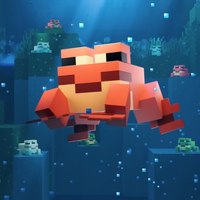Minecraft with RTX is breathtaking but painfully exclusive
There's no finer example of ray tracing today, but that comes at the cost of Minecraft's greatest asset.
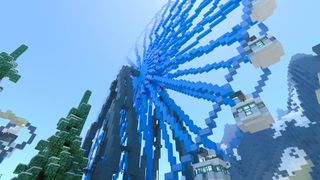
Step out onto the promenade of Imagination Island and you'll be greeted with an expansive park filled with roller coasters, food stands, and a cathedral that would give the Sagrada Família a run for its money. It's a Minecraft with RTX world built by creator collective BlockWorks, and every inch has been reconstructed, during what I can only assume was an excruciating construction process, to fit a new set of rules: physically based rendering (PBR).
Physically Based Rendering is key to Minecraft with RTX's visual overhaul. The public Minecraft with RTX beta will launch today, April 16, and the complete (and free) RTX update is set to follow later this year. It encompasses the game's most engrossing and significant visual overhaul since it first launched in 2009, and comes flaunting a full suite of ray-traced effects—including reflections, illumination, shadows, and refraction—through the use of an all-encompassing path tracer.
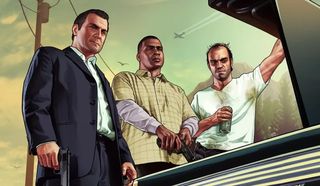
Best PC games: All-time favorites
Best free PC games: Freebie fest
Sims 4 cheats: Life hacks
GTA 5 cheats: Phone it in
GTA 6: Grand theft next
2021 games: This year's launches
The path tracer, I'm told, is similar to that which Nvidia Lightspeed Studios built for Quake II RTX. It's built atop Minecraft for Windows 10's Bedrock platform, and once again demands a switch from Minecraft's ageing Java edition. Unlike other RTX titles before it, Minecraft with RTX uses a path tracer utilising the computationally intense ray tracing process to generate a frame from the ground up. Where, say, Battlefield 5 or Control feature a select few ray-traced effects, a path-traced game has access to all of the effects that a physics-based, true-to-life render process can offer.
But in order to operate the path tracer for lifelike effects, you must first prepare your geometry. That's where physically based textures come in: a new collection of material properties for every Minecraft block. Whereas each game block populating the map used to come with two base properties—colour and opacity—the new Minecraft with RTX guidelines introduce four more: metallic, normal (height map), emissive (light emission properties), and roughness.
So if BlockWorks' RTX theme park doesn't inspire awe at its sheer scale already, these further four dimensions to every block make for a logistical construction nightmare. But fear not, most of the work's been done for you ahead of Minecraft with RTX's launch. Many blocks have been given a fresh lick of paint ahead of time by Nvidia and the creative team over at Razzleberries, who are both introducing HD resource packs, two a piece, in aid of making the RTX endeavour a little less a daunting for newbies. There are also Minecraft with RTX guides available for any curious minds that want to try their hand at creating their own.
Which all goes to highlight the effort that has been sunk into Minecraft with RTX over the better part of eight months, likely longer, to get it into a shape for public beta.
For a game I at first felt was unworthy of a ray tracing makeover, Minecraft is a particularly rousing example of the use of the new rendering technology. Its blocky graphics are amplified tenfold with ray tracing, without losing sight of the celebrated simplicity that made the game so great to begin with. Physically based texture changes—such as those to brickwork, switches, or carved stone—add only minor flourishes to the surface of the block, yet serve to completely overhaul the look and feel of the game world.
The biggest gaming news, reviews and hardware deals
Keep up to date with the most important stories and the best deals, as picked by the PC Gamer team.
But while the game sticks to its graphical roots, it has lost a good deal of its accessibility along the way. "The full path tracer in Minecraft is graphically intensive" an Nvidia spokesperson tells us. And it shows.
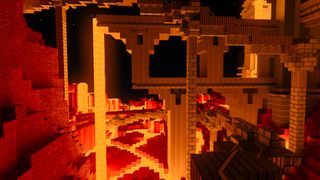
Nvidia touts three "key new technologies" introduced with Minecraft with RTX: the path tracer, physically based texture system, and DLSS 2.0. Each one just as necessary as the last to making Minecraft with RTX a playable reality.
Whereas games such as Control and Wolfenstein: Youngblood have seen considerable DLSS 2.0 performance enhancements, and with little to no visual impact, the feature remains a useful, but not obligatory, extra. That's not the case in Minecraft with RTX, however, in which Nvidia's AI-super sampling wunderkind is prerequisite to 60fps+.
But first let's get the disclosure out of the way: our numbers are not representative of the final performance of the game. Nvidia is promising to further train and improve DLSS 2.0 between now and the official release, so we may find further speed or fidelity improvements come launch day.
At least for now, with an RTX 2080 and a Core i7 9700K plugging away at 1440p in my test rig, and with DLSS 2.0 enabled in 'Balanced mode', we're experiencing some creaks and groans. Our frame rate average bobs over 60fps for the most part, but swiftly drops to the low 40s when gazing out into an open vista - as we are surely wont to do in a game as stunning as this.
| Header Cell - Column 0 | Avg (fps) | Min (fps - 99th percentile) |
|---|---|---|
| 1440p | Row 0 - Cell 1 | Row 0 - Cell 2 |
| RTX enabled / DLSS 2.0 enabled | 67 | 51 |
| RTX enabled / DLSS 2.0 disabled | 30 | 22 |
| RTX disabled | 192 | 118 |
| 1080p | Row 4 - Cell 1 | Row 4 - Cell 2 |
| RTX enabled / DLSS 2.0 enabled | 83 | 67 |
| RTX enabled / DLSS 2.0 disabled | 50 | 38 |
| RTX disabled | 208 | 125 |
For reference, the DLSS render resolution is set automatically depending on output resolution: 'Quality' at 1080; 'Balanced' at 1440p, and 'Performance' at 4K.
Without DLSS 2.0 things get even more dour. While DLSS is near-indistinguishable from native rendering, if you are intent on disabling the setting (which is on by default) you can expect a performance drop of 55%. All of which makes for stark comparison to the 192fps average possible with the ray tracing effects disabled.
At 1080p performance is a little more rosy, at 83fps with DLSS 2.0 enabled. But once again our RTX 2080 drops below 60fps with DLSS disabled. The game also appears to hit the performance buffers over 200fps, hence the marginal performance increase between 1080p and 1440p with both RTX and DLSS 2.0 disabled.
Ray tracing has been successfully shifted away from purely a photorealism endeavour and onto one of the globe's most loved and idiosyncratic games
In Nvidia's in-house testing, within a creator world from PearlescentMoon, an RTX 2080 Ti with Intel's finest Core i9 9900K—a frightfully expensive gaming PC combo—manages just 77fps at 1440p with DLSS 2.0 enabled. You ought to be thankful for that, too. The same rig reported just 36fps on average without Nvidia's neural network to help.
Gaming laptops are similarly fated to slim pickings in performance. In Nvidia's testing, an RTX 2080 Max-Q manages 57fps with DLSS 2.0 enabled, and just 32fps without. Nvidia is once again promising further optimisation between now and the update's release, and states "laptop performance will vary from world to world based on scene complexity." The same statement holds true on desktop, as well.
But perhaps the six worlds included within the Minecraft with RTX beta are not representative of "real-world performance". From BlockWorks' Imagination Island to Razzleberries Of Temples & Totems RTX, or Dr_Bond's Aquatic Adventure, each creator island is brimming with surfaces ripe for ray tracing. The same can be said for Crystal Palace RTX by GeminiTay or Colour, Light, and Shadow RTX by PearlescentMoon. A survival mode venture into the great unknown will surely turn up fewer screen-consuming disco-castles constructed exclusively of diamonds, glowstone, and shimmering stained glass. But perhaps that's also missing the point of a sandbox game such as this.
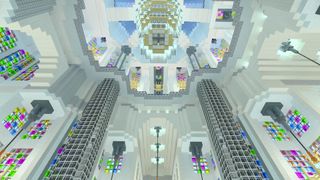
Evidently Minecraft with RTX is a double-edged sword. It's a stunning and inspired use of ray tracing, and one that I'll admit I was not expecting to blow my socks off as it has. Even I, a lapsed Minecraft obsessive, find myself strolling around these carefully crafted game worlds just for the simple pleasure of taking in all that they have to offer. Its beauty is sure to inspire further users to capture and share their creations.
But I'm running this on an $700 RTX 2080 graphics card, and, no matter what Nvidia's sales figures may allude to, many Minecraft fans will not be able to enjoy the game in what is most definitely its most beautiful form to date. Not until the Xbox Series X undoubtedly spews fourth some Minecraft with Radeon Rays creation, anyways. It feels like no matter the reasonable availability of a cheap DXR-compatible card in the near-future (we're all holding out for AMD to champion performance per dollar), there's no bridging the game's steep system requirements for many of its existing >100 million active monthly players.
We're not out of the woods when it comes to the disproportionately weighted impact of RTX on performance, despite Nvidia's admittedly impressive efforts with DLSS 2.0.



At least RTX compatibility won't be demanded on entry to an RTX server at launch. Once the complete update makes its way to our machines—at which time multiplayer functionality will be enabled—you'll be able to enjoy servers built with physically based textures without any such need for highfalutin RTX silicon residing in your own machine. You will have to settle for the Minecraft graphics we've been otherwise content with for the past 11 years, but at least there's something to be said for Imagination Island as a spectacle in itself even without a path tracer to buff and polish it up.
In a game renowned for easy-going system requirements, unequivocally the 'run on a potato' champion, the inability to share your experience universally among friends leaves a sour taste. The sky should be the limit in a creative sandbox, not your GPU's core count or how much money you're willing to spend. It's the same quandary that faces all burgeoning technology as it stands on the precipice of mainstream adoption: at some point or another, you're going to price someone, somewhere, out of the market. As unavoidable as it may be, however, it stings worse than ever in a game of as monumental a cultural impact as Minecraft.
But you shouldn't let that wholly detract from what's been achieved here. Ray tracing has been successfully shifted away from purely a photorealism endeavour and onto one of the globe's most loved and idiosyncratic games—and to staggering effect. There's truly no better flagship for ray-traced rendering today than Minecraft with RTX.
Minecraft seeds: Fresh new worlds
Minecraft texture packs: Pixelated
Minecraft skins: New looks
Minecraft mods: Beyond vanilla

Jacob earned his first byline writing for his own tech blog. From there, he graduated to professionally breaking things as hardware writer at PCGamesN, and would go on to run the team as hardware editor. He joined PC Gamer's top staff as senior hardware editor before becoming managing editor of the hardware team, and you'll now find him reporting on the latest developments in the technology and gaming industries and testing the newest PC components.

Palworld developer reports Nintendo's suing over 3 Pokémon patents for only $66,000 in damages, but a videogame IP lawyer says fighting the lawsuit could mean 'burning millions of dollars'

No Man's Sky gets cross-save on a dozen platforms and brings back Mass Effect's Normandy as a limited-time rewar
Most Popular



